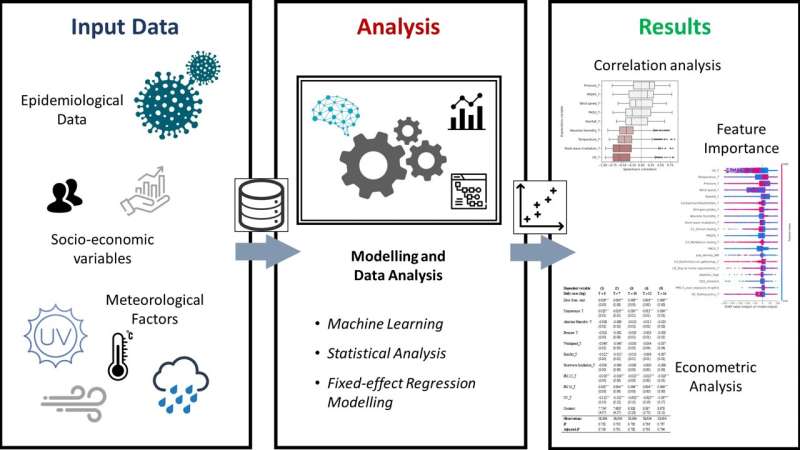Climate data can help model the spread of COVID-19

COVID-19 transmission can be more accurately modeled by incorporating meteorological factors, with ultraviolet (UV) radiation as the main driver, according to a new study published this week in the open-access journal PLOS ONE by a team of scientists from the Qatar Environment & Energy Research Institute (QEERI), at Hamad Bin Khalifa University and Transvalor S.A., France.
A growing number of studies suggest that climate may impact the spread of COVID-19 but the extent to which it modifies COVID-19 risk and transmission is not well understood. Studies on the impact of climate have been piecemeal or poorly controlled—limited to single countries, only taking into account a few climatic parameters, or ignoring socioeconomics, for instance.
In the new paper, the researchers studied data on reported COVID-19 cases in 196 countries over a 14-month period, using socioeconomic, environmental, and global health factors as control variables. They developed three different analytic approaches—statistical, machine learning and econometric—which modeled the potential contributions of climate to confirmed case numbers.
The results suggest that while disease susceptibility, lockdown compliance, and increased testing are the most effective strategies for preventing the spread of COVID-19, UV radiation is the climate factor most strongly correlated with the spread of COVID-19, with greater UV radiation associated with reduced transmission. For other meteorological and air quality factors, including temperature, absolute humidity and solar radiation, discrepancies between results in the three analysis methods emphasized the difficulty in understanding the correlations. For instance, humidity was positively correlated with COVID-19 spread in the machine learning analysis and negatively correlated in the econometric analysis. Temperature was moderately negatively associated with COVID-19 in the statistical analysis but positively correlated with COVID-19 transmission in both the machine learning and econometric analyses.
The authors conclude that UV radiation emerges as the most impactful meteorological factor in COVID-19 transmission across all methods. This could help refine transmission predictions based on seasonality or weather forecasts, and help inform future pandemic response measures that limit the economic impact of complete lockdowns. They point out that this is supported by overwhelming evidence that UV light can effectively kill SARS-CoV-2 and other coronaviruses.
The authors add: "The impact of climate on COVID-19 transmission rates has been the subject of many studies, but it is still poorly understood. In our study we demonstrated that meteorological factors play a key role in statistical, machine learning and econometric analyses of COVID-19 risk, with ultraviolet radiation (UV) as the main driver."
More information: Does climate help modeling COVID-19 risk and to what extent?, PLoS ONE (2022). DOI: 10.1371/journal.pone.0273078


















